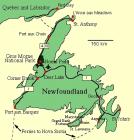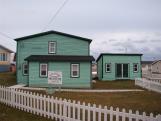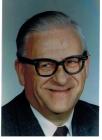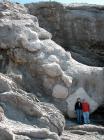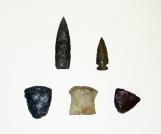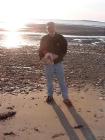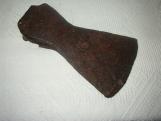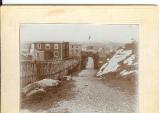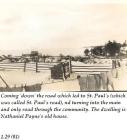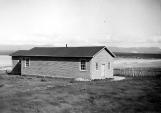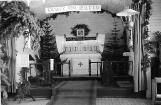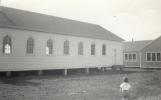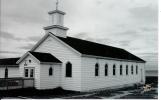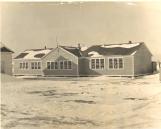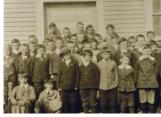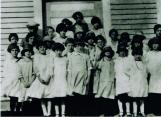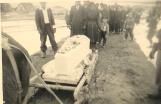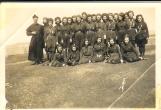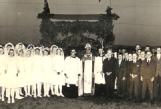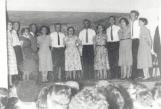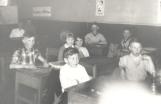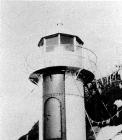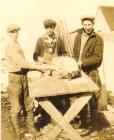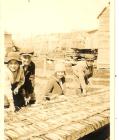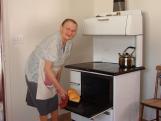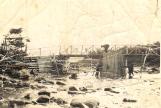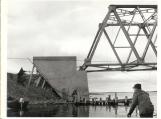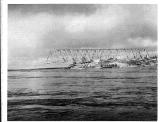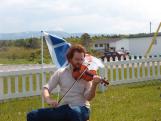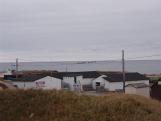

Dr. Henry N. Payne Community Museum
Cow Head, Newfoundland and Labrador
3
Cow HeadLocated on the West Coast of the Great Northern Peninsula, Cow Head has been called by many names. It was first named Cap de Pointe by Jacques Cartier on June 16, 1534. However, the French renamed it "Tete de Vache". It has also been called Cape Pointu, Cow Harbour, Cow Cove, Tuckers Cove, the Head, Summerside, Winterside, Shallow Bay or we may sum them all up and say Cow Head.
Traditionally divided into two parts, Winterside or the "main" and Summerside or the "head",the division reflects the two locations where early settlers resided depending on the season.
This exhibit will tell the story of the early people of Cow Head centering around the social life of church, school and the family, and the development of its society through images and documentation, focusing mainly from the early to mid 20th century.
5
Our MuseumCow Head is home to the longest running museum on the West Coast of Newfoundland. It started in 1975 as the Tete de Vache Museum. Over the years the museum made several moves and in the early 1990's the Cow Head Conservation and Heritage Committee decided to find a "resting place" for the museum artifacts.
In 1999 the museum opened under a new name, the Dr. Henry N.Payne Community Museum.
It was named after a prominent community leader whose family very generously donated the house to be used as a community museum. Their only request was that the museum take his name.
7
Dr. Henry N. Payne 1906-1986Born in Cow Head June 28, 1906 to William Wallace and Hannah Maria Brake, Henry was one of nine children. Mr. Payne accumulated 45 years of faithful service to the teaching profession. He was very active in the community and served as a layreader in the Anglican Church for sixty years, Justice of the Peace, field worker for the co-operative movement, member of the library board, parish council, local improvement board and executive member of the St. Barbe South Integrated School Board. Receiving many awards and certificates his crowning achievement occurred in 1975 when he was awarded an honorary Doctor of Laws from Memorial University of Newfoundland.
11
500 Million Years AgoAround the Cow Head Peninsula layers of limestone conglomerate form the coastline. Pieces of shallow water limestone tumbled from the edge of the carbonate bank that formed along the continental shelf about 500 million years ago.
When underwater landslides occurred the limestone later hardened into a natural concrete called "breccia". The limestone chunks found on "The Head" are often several meters across and are blanketed by layers of fine mud which have solidified into black shale.
The Cow Head breccias are important for their large size and thickness and for the fossils contained within them. Here geologists can compare shallow-water organisms and deep- water organisms. These organisms tell what life forms were present and the age of the strata. They also provide information about their depositional environment. They provide one of the best opportunities in the world for learning about the different marine environments of that time.
13
AND THEY CAME BEFORE US!During excavations led by James Tulk in the mid 1970's archaeological excavations were uncovered to reveal that Europeans were indeed not the first people to visit Cow Head.
From the sites uncovered, more than two thousand artifacts were removed and taken to St. John's for further study and preservation. These sites contain artifacts from Maritime Archaic, Groswater Paleo and Recent Indian. It is now believed these artifacts date back 2300-4500 years ago and that these people may have came to Cow Head to quarry the Chert.
Chert is a hard glassly rock formed by the precipitation of silica in deep water and was used by the native people to make their tools.
Maybe Cow Head was used as a stopover to gather chert and make their tools as Cow Head chert has been found in other archaeological sites as far north as Labrador. Cow Head chert was probably used because of its very high quality.
15
700 Year Old Walrus Skull14 September 2004
Dr. Henry N. Payne Community Museum, Cow Head, Newfoundland
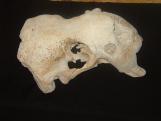
16
Walrus SkullThis skull washed up on the beach in Cow Head and was found by a gentleman in 1993.
It is the skull of a female Atlantic Walrus and isotope dating shows that she lived about 700 years ago. The tusks are quite worn and a hole above her right tusk is probably the result of a large abcess which may have led to an infection which caused her death.
Walrus were quite common in this area and tusks and bones have been found along the coast. An account from the mid 1800's mentions Cow Head fishermen using the tusks for oar locks in their boats. It was probably one of the few places in the world where fisherman used ivory oarlocks.
18
In 1919 a road was widened from the head to the mainland and the remains of the two murdered men were uncovered. Buried with the bodies was the axe.19
DOUBLE AXE MURDERA story we do not take great pride in but is nevertheless part of our history is the double axe murder.
In 1809, before Cow Head was settled, a gruesome murder took place here. According to court transcripts we were referred to at that time as Shallow Bay.
Trading stations opened in Bonne Bay in the early 1800's and people were hired as furriers to go out to the countryside and trap.
John Pelley(referred to by the local people as
"old Peely")was one of those hired. We are told he came from Ireland, not as a regular immigrant but as a fugitive from justice. John Pelley came to Shallow Bay.
Two other furriers from Rocky Harbour,Joseph Rendell and Richard Cross also came to Shallow Bay. We do not know if Pelley felt they were encroaching on his traplines or as some stories say, one of the men may have been planning to cut a boat timber. Whatever the reason being, John Pelley murdered both men.
Sarah Singleton became worried when her brother and fiance had not returned so her and a gentleman by the name of John Paine walked to Shallow Bay to look for her brother and his companion. They were suspicious when Sarah saw blood, even though Pelley swore he had not seen the two men. They returned to Rocky Harbour to gather more people and returned to Shallow Bay.
The search party came and located Pelley. He confessed to the murders and was taken to Bonne Bay and then on to St. John's. A trial was held and Pelley was hanged for his crime.
Copies of the court transcript and the axe reside at the Dr. Henry N. Payne Community Museum in Cow Head. A production of this story,"The Double Axe Murder" can be seen at the Gros Morne Threatre Festival, Cow Head during the summer months.
21
Tombstone of Mary PayneMary died at the age of 69
It is believed that John and Mary married in 1810.
22
Our First SettlersJohn Charles and Mary Payne
It is believed that John or Charles or John Charles Payne came from Christchurch, Hampshire, England. It was once thought he married his wife Mary Brooks before he came to Newfoundland. Others now believe that Mary came from the Bay of Islands and was indeed a Park whose mother married a Brooks in a second marriage. However they met, it is believed that John used Burin as a winter base and came to Cow Head to fish in the spring and returned to Burin in the fall. At that time Cow Head was part of the French Shore and was only inhabited during the fishing season.
In 1816 , on one of their trips to Cow Head a son Charles was born and John Charles and Mary decided to winter in Cow Head and made their home in Tucker's Cove.
27
Winterside and SummersideThe community of Cow Head formerly consisted of two parts. Winterside on the mainland and Summerside on the peninsula or "the head". The head and the mainland are connected by a natural isthmus we call "the Sandbank".
Each spring the families on Winterside moved their belongings to their summer houses on "the Head" and returned in the fall when the fishing season ended.
The Head was the center of all fishing activity and was the site of the school chapel, telegraph office and several businesses.
In 1968 , under the Fisheries Resettlement Program 24 families remaining on Cow Head Summerside were relocated to Winterside and "the Head" is now being used mainly as a fishing village.
29
SCHOOL CHAPELIt is unknown if this building is the first or the second school chapel.
31
Chancel of school chapel decorated for the Christmas season.33
St. Mary the Virgin Church under construction.35
One Church, One MissionThe seeds of the first church were first sown by the early settlers who originated from England and settled here in 1816 and by the great Bishop Feild who conducted service in a Mr. Vincent's home in 1842.
The credit of building the first school chapel in Cow Head belongs to the Rev. Joseph James Curling, mostly at his own expense. He also paid the salary of a teacher. The school chapel was built sometime during his fifteen year stay in this area which was between 1873 and 1892.
A school was built on Winterside to accomodate pupils whose families migrated there for the winter months when the school on Summerside was closed.
The school chapel served its purpose until 1926 when a new school chapel was built. The first couple married in the school chapel was John L. (Lighthouse Jack) and Georgina (Brophy) on May 5, 1926.
The mission of Cow Head was created in 1916 with its first incumbent being Rev. Thomas Greavett of Sussex, England.
School chapels were used for services and upon the arrival of Rev. Charles Abraham a church building was started in 1954 and completed in 1956. It was consecrated on July 7, 1958 by Bishop Robert L. Seaborn.
The Church of St. Mary the Virgin is still being used today.
Slowly additions were made for the schooling on Winterside and with a marked increase in
birth rate and projected increase in the pupil enrolment additions were completed in1959 for all grades from primer to grade 11. This was in addition to the one room school on "the Head".
In 1962 the Greavett Memorial Central High School opened to serve the communities of St. Paul's, Cow Head, Three Mile Rock and Parsons Pond. The school accomodated students from grades seven to eleven. St. Mary the Virgin School located behind the church, taught primer to grade six. For a short period of time there was a school in Belldown's Point and when it closed the students were bused to Cow Head Winterside.
A new elementary school was built near the Central High School , a gymnasium was added and eventually a new high school was built and connected, becoming what we now know as the Long Range Academy.
Church and school played an important part of social life as the community was centered around both. Community groups were formed as part of the church and quite often the functions held in the community were for the benefit of one or the other. The people built the schools themselves and the men provided the firewood to keep them heated while the women kept them clean.
37
St. Mary the Virgin School41
School girls 1930?43
Orangemens' Day Parade45
Wedding of Bertha and Kenneth Payne47
Wedding of Caroline and Reggie Payne49
Typical Cow Head funeral in the early days.51
1st Cow Head Girl Guide Movement started in 1947.55
Three act plays were often performed at the school in Cow Head.59
Cow Head LightIn 1904 France relinguished their fishing rights along this shore and the Newfoundland Government built lighthouses along strategic points.
The lighthouse in Cow Head was built in 1909 in the hollow of a promontory on Cow Head Summerside.
The first light keeper was Jesse Payne who lived in a small three bedroom house in a sheltered area just below the light. When Jesse passed on, his son John L. or Lighthouse Jack as he was known became light keeper.
A large kerosene lamp, similar to an Aladdin Lamp was used for light. The light was lit when navigation opened in the spring and remained lit until navigation closed, usually in December.
In 1952, the light was lit by acetylene gas and as there was a automatic timer on the new lamp Lighthouse Jack's job was reduced to keeping a check on the light and cleaning the lenses. As a result his wages were greatly reduced and he moved his family to Tuckers Cove and became a fisherman as well as light keeper.
Cow Head light became battery operated in 1978 and remained in operation until 1988 when Transport Canada discontinued using the light. Harbour Buoys were used instead.
At the time of closing, Jesse, John's son was light keeper.
62
Cow Head FisheriesThe early settlers of Cow Head made their living fishing for cod, herring, salmon and capelin. During the winter months they trapped for furs.
Thomas Street Bird and company, based in Dorset, England, began trading with the fishermen and trappers of Cow Head early in the 1800's. By mid century, Bird and Company had withdrawn from the region and was replaced by traders based in St. John's and Nova Scotia.
The lobster fishery developed later in the 19th century. By 1887, lobster canning factories at both Cow Head and Cow Cove were operating. Family run lobster factories continued until the 1930's and in 1921 there were 20 lobster factories operating in Cow Head.
In 1939, a lobster pool was formed and lobsters were shipped to Massachusettts. This was the beginning of a long standing tradition of successful co-operatives in Cow Head.
Only a handful of fisherman remain today.
64
The Logging IndustryThe 1920's saw the beginning of the logging industry in Cow Head. From 1920 to 1960 , three to six small sawmills were operating at Cow Head at any given time. The mills were supported by pulpwood cutting contracts for the Bowater Company in Corner Brook. In 1921, the population of Cow Head was 231. By 1956, due in part to the logging industry, the population had increased to 448. This gave Cow Head a significant second industry.
66
Domestic LifeIn Cow Head as in most other parts of rural Newfoundland and Labrador many changes occured in the lifestyle of the community after the province became part of Canada in 1949. Additional sources of income,roads, electricity and the telephone made life easier.
Domestic chores such as laundry which was once done completely by hand using a wash tub and scrub board and wrung by hand could now be done in gas powered washing machines.
Wool no longer had to be carded and spun before being knitted into articles of clothing. Worsted was more readily available to buy at the local stores or could be ordered from woolen mills. This made life much easier for the women who had to knit everything from mittens to long underwear for their large families. This was no easy task and the women welcomed the change.
The stove was used for more than just cooking, also for heating the home as well. Quite often homes had more than one stove as this was their only source of heat and would have to be kept burning throughout the night.
All the family cooking was done on the stove. The women provided three square meals a day for their families. As bread was a staple of the family diet it had to be made every day or several times a week.
Sugar, flour and tea were acquired from local merchants but families lived mainly from the land and from the sea.
71
Bridge across St. Paul's TickleIn 1911 a bridge was finally built across the tickle connecting St. Paul's to the rest of the peninsula. It was completed just before Christmas and on New Years Eve it was carried in with the ice through the tickle.
In 1955 a flat top began to carry vehicles and passengers across the tickle. Cables were needed to keep the flat top from foating away with the tide. Only one car at a time could travel on the flat top.
The Bailey bridge was built on the north side of the tickle and floated across on November 14,1962.
With the bridge in place, life changed dramatically for the people of Cow Head and beyond. They no longer considered themselves isolated and were able to travel freely beyond their normal domain.
74
Cow Head TodayCow Head is now a community with all the household conveniences of the modern world. In addition to our Church, School, Museum, Library and Clinic, we now have a liveTheatre. The Gros Morne Theatre Festival operates from the Warehouse Theatre from June to September. The impact on tourism has been phenomenal.
Before the fishery moratorium Cow Head was a thriving, growing community with a population of close to a thousand people. Since the down turn of the fishery, the population has been cut in half. There are few businesses remaining and people travel to Deer Lake and Corner Brook to do most of their shopping. Only a handful of fishermen remain .They still travel to the ice floes during the spring for the annual seal hunt.
The larger fish plant closed at the time of the moratorium and a smaller one remains opened. H. Hopkins a fish buyer from Nova Scotia still employs upwards of about 20 people during the peak season which runs April to September. Cod, lump row and ground fish are processed at the plant.
Most men either work away from home for long periods of time or travel and come home daily. Women work mostly in the service industry. The service industry has a very short season and provides mostly minimum wage jobs.
Although quiet during the winter months Cow Head becomes a flurry of activity and excitement as the tourism season approaches.

